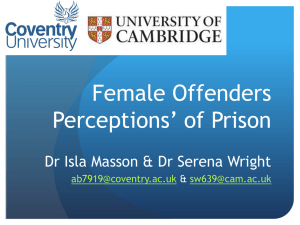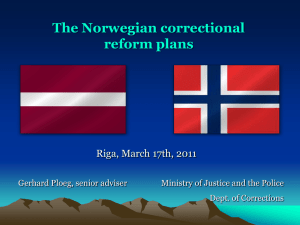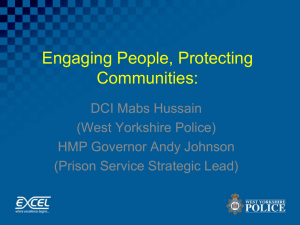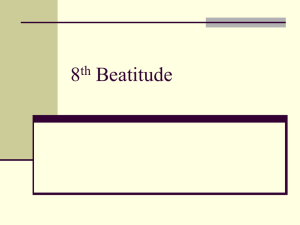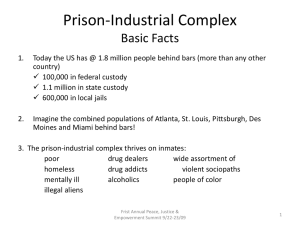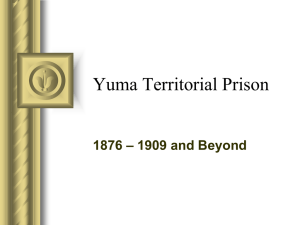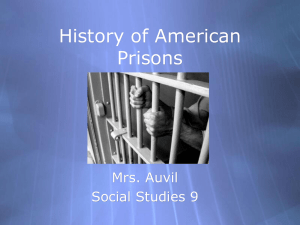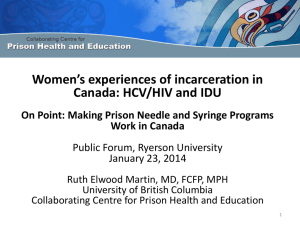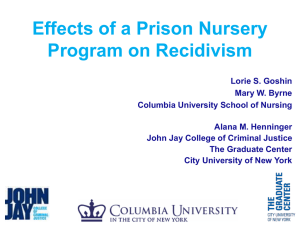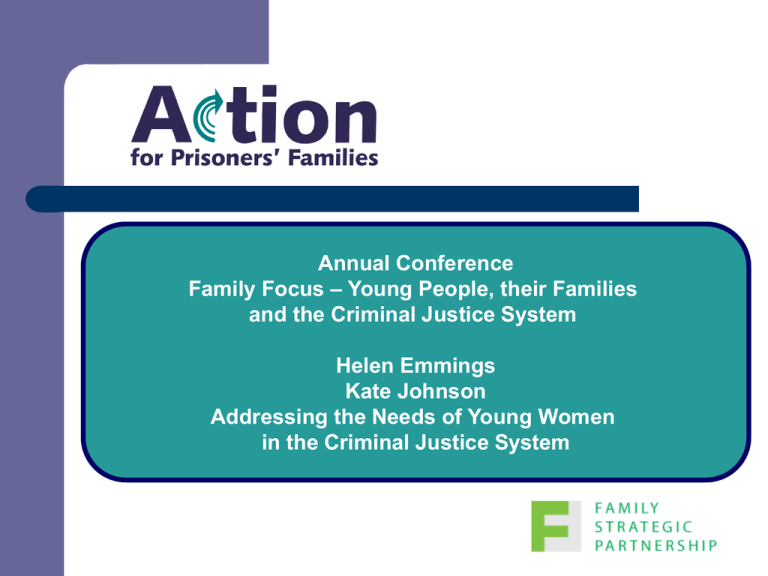
Annual Conference
Family Focus – Young People, their Families
and the Criminal Justice System
Helen Emmings
Kate Johnson
Addressing the Needs of Young Women
in the Criminal Justice System
Addressing the Needs of Young
Women in the Criminal Justice
System
Helen Emmings
Kate Johnson
5th December 2012
Who we are
Women in Prison (WIP) is a charity working
with women at risk of going to prison, in prison or in
the community to promote their resettlement, personal
development, education and training. We have been
running for over 25 years.
We educate the public and policy makers about women
in the criminal justice system and we promote
alternatives to custody.
“Taking the most hurt people out of society
and punishing them in order to teach them
how to live within society is, at best, futile.
Whatever else a prisoner knows, she knows
everything there is to know about punishment
because that is exactly what she has grown up
with. Whether it is childhood sexual abuse,
indifference, neglect; punishment is most
familiar to her.”
Chris Tchaikovsky- Former prisoner
and founder of Women in Prison
Policy & Campaigning
Planning, developing and carrying out
policy and campaigning activities in order
to highlight issues of concern to women
within the criminal justice and to push for
action by government and other agencies
to address those issues.
Profile of Female Offenders
Quiz
Current Population
There are 13 women’s prisons in England and none in
Wales.
Women represent 5% of the overall prison population.
There are only 3 prison establishments in England which
can receive young women (under 18 years old). They
are in Surrey, Gloucestershire and West Yorkshire.
In 2009 there were 753 women held in prisons over 100
miles from their home.
Prison and General Population
Characteristic
Ran away from home as a child
Prison population
Female
Male
50%
47%
Taken into care as a child
General population
Female
11%
27%
Regularly truanted from school
Male
2%
30%
3%
Excluded from school
33%
49%
2%
No qualifications
71%
52%
15%
Numeracy at or below Level 1 (11yrs)
65%
23%
Reading ability at or below Level 1
48%
21-23%
Unemployed before imprisonment
67%
5%
Homeless
32%
0.9%
Diagnosed with two or more mental
illnesses
70%
72%
2%
5%
Drug use in the previous year
55%
66%
8%
13%
Hazardous drinking
39%
63%
15%
38%
Growth
In the last decade the women’s prison
population has gone up by 60%.
In 1995 the mid-year female prison
population was 1,979
In 2000 it stood at 3,355
In 2007 it was 4,283.
-Ministry of Justice (2009) Offender Management Caseload Statistics
2008, London: Ministry of Justice
Previous Convictions
27% of women in prison had no previous
convictions, over double the figure for men.
-Prison Reform Trust 2010
12% of women serving sentences of under six
months had no previous convictions, compared
with only 5% of men.
-Ministry of Justice (2009) Offender Management Caseload Statistics
2008, London: Ministry of Justice
Sentencing
Most of the rise in the female prison population
can be explained by a significant increase in the
severity of sentences.
A woman convicted of theft or handling stolen
goods in the Crown Court is now twice as likely
to go to prison as she was in 1991. In
Magistrates Court - increase in custody even
higher.
Justice and Equality: Second Annual Review of the
Commission on Women and the Criminal Justice System.
Fawcett Society: 2006
Remand
Women on remand make up 18% of the female
prison population
-Ministry of Justice (2010) Population in Custody, England and Wales, April
2010, London: Ministry of Justice
The number of women on remand increased by
105% between 1995 and 2005, compared with a 24%
increase for men.
-Bromley Briefings Prison Factfile 2006, Prison Reform Trust.
These women spend an average of four to six weeks
in prison and nearly 60% do not go on to receive a
custodial sentence.
-Department of Health (2009) The Bradley Report, Lord Bradley’s report on people with
mental health problems or learning disabilities in the criminal justice system,
London: Department of Health
A Life of Exclusion
Women in the Criminal Justice System have
experienced lives often characterised by
abuse, mental illness, poverty, educational
under attainment, poor housing and
substance misuse.
These experiences are compounded by
experiences of prison, a system based on
disempowerment and control.
‘Walk the Line’
Exercise
Experiences of Abuse
40% of young women in custody(aged
between 18 and 21) report having suffered
violence at home.
Over 30% of young women in custody
(between the ages of 18 and 21) report having
experienced sexual abuse at home.
Experiences of abuse make engagement with
services more difficult.
Barriers to Engagement
Emotional
Difficulties trusting people due to experiences within
personal relationships.
Extensive contact with welfare agencies from childhood
and/or as mothers.
Powerful emotions in terms of view of themselves &
authorities.
Difficulties disclosing experiences from past or to be
honest about current situation.
Avoidance – based on fear.
Withholding info for fear of recall.
Barriers to Engagement
Practical:
Time needed to establish positive relationships
Prisons far from home – so contact with family
limited
Changing caseloads of professionals leading to a
feeling of being ‘passed from pillar to post’
Conflicting demands on time, particularly for
young women.
Practically more likely to affect women than
men.
Mums in Prison
66% of women and 59% of men in prison have
dependent children under 18.
- Of those women, 34% had children under five, a
further 40% children aged from five to 10.
40% of women under 18 in prison are mothers.
Each year it is estimated that more than
17,700 children are separated from their
mother by imprisonment.
Mums in Prison
One Home Office study showed that for
85% of mothers, prison was the first time
they had been separated from their
children for any significant length of time.
Home Office Research Study 162 (1997), Imprisoned Women and
Mothers, Home Office: London
Intergenerational Offending
Having a mother involved in the Criminal
Justice System presents an increased risk of
daughters also developing offending
behaviour.
May have different routes than for sons e.g.
acquisitive offending, sex work, domestic
abuse and substance misuse.
Equality
Equality is about more than equal treatment.
Equality can require different treatment to
deliver an equal outcome.
Programmes to support prisoners’
resettlement will disadvantage women if they
do not respond to the distinct root causes of
women’s offending.
Case Study
For the case study consider the following:
What key needs do Gemma and her family
have?
What barriers might Gemma face?
What sort of services would (in an ideal
world) be most appropriate to address her
needs?
What services in your area offer something
you would like to share with your group?
Questions?
Women’s Support Centre (Surrey)
19a High Street
Woking
Surrey`



